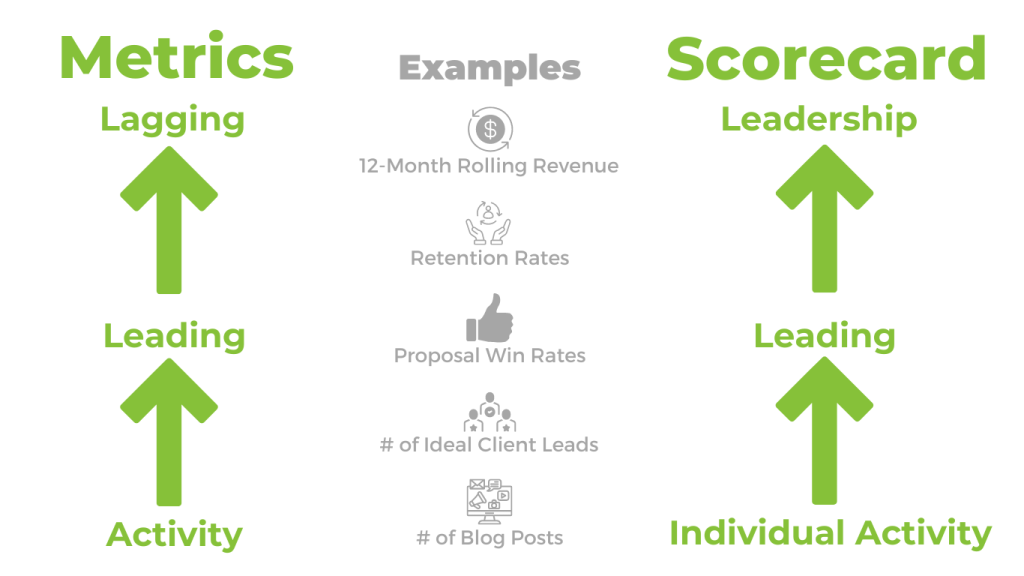
by Bill Poole | Mar 7, 2023 | Strategy
The process of developing the right scorecard for your business can be frustrating and is a journey. Does any of this sound familiar to you?:
- Am I tracking the right metrics to support my business?
- I have hopeless, long streaks of red for certain metrics on my scorecard.
- Are my metrics at the right level (Leadership, Departmental)?
- Some of my metrics make it difficult to take the proper action.
The purpose of this blog post is to help you break through these challenges. We will:
- Position the difference between leading, lagging, and activity metrics.
- Describe the ideal state of an actionable scorecard.
- Help you determine what metrics should be on your scorecard at what level.

Lagging, Leading, and Activity Metrics
One way to think about metrics is that they are on a vertical spectrum to align with the leadership hierarchy. On the upper end of the spectrum, you have lagging metrics. These are the metrics that you would find on a business plan or V/TO®, and you might also find them on the leadership scorecard. On the lower end of the spectrum, you have activity metrics and would likely see these at the departmental level and also have individuals that own these activity numbers. Leading are on the spectrum and fit somewhere in between. Let’s look at each one:
Lagging Metrics: Lagging metrics are closely connected to the business’s high-level goals. The challenge with lagging metrics is that they are hard to affect on a weekly basis. An example of a lagging metric is 12-month rolling revenue.
Leading Metrics: Leading metrics give you an early indication of whether or not you will be meeting your business goals and lagging metrics. While an early indicator, leading metrics are not always easy to control on a weekly basis. Examples of leading metrics for sales reps would be proposal/win rates or retention rates for an Account Manager position. An example of an operational metric is Onboarding Client Satisfaction.
Activity Metrics: Activity metrics are based on the activities you must do to ensure the leading metrics trend in the right direction and the business goals are met. The idea with activity metrics is to be able to look at your activity metrics when you close out your week on Friday and know if you had a good week. Examples of activity metrics include # of outbound calls made or # of social posts. In short, lagging metrics are what you are trying to achieve, activities are what your team needs to do, and leading metrics let you know if you are getting there. Now that this context is understood, let’s look at the ideal state of a scorecard and what metrics you should be tracking and on what level.
Scorecard – Ideal State
In its purest sense, a mature scorecard consists only of the metrics that you can control on a weekly basis. What is a mature scorecard? A mature scorecard is where the metrics are tight from top to bottom. The activities that you are doing are going to drive the leading metrics that directly drive the lagging metrics and high-level business goals.
So, you should see a lot of activity metrics on departmental scorecards. As you move up toward the leadership level, there are likely fewer activity metrics. That said, any leading metrics should be closer to the activity metrics than the lagging metrics on the spectrum we discussed above.
When you are tracking the right activity and leading metrics, there is limited value in tracking the lagging metrics on a weekly basis, especially when you come down from the leadership scorecard. Until you get to that point, it sometimes helps to have visibility to leading and sometimes lagging metrics.
Lagging metrics on lower level scorecards can have a negative impact because they are not actionable. This is likely the case if you see 13 weeks of red across your scorecard. It is a de-motivator.
When you see long streaks of red or green for activity metrics, you could be tracking the right metrics but not changing the target goals for the metric, making it hard to take the right action. Ensure your goals:
- are achievable goals within reach
- motivate not deflate
What metrics on what level?
Understanding what metrics to put on a leadership scorecard vs. lower-level scorecards can be a big challenge. The rule of thumb is that you should have the metric at a level that can be controlled. For example, # of outbound calls made should not be on the leadership scorecard, and the retention rate should not be on the scorecard for the Sales Development Rep (SDR) team.
Metrics on the leadership scorecard should be actionable for the leader that sits in the seat, even if it is not an activity metric. For example, # of qualified leads could be the primary marketing metric tracked on the leadership scorecard. If that number is off, the sales and marketing leader should know what corrective action their team should take by looking down a level at the sales and marketing scorecard. Activity metrics to support # of qualified leads might be # of calls with referral partners or # of social or blog posts.
As we have said, turning your scorecard into a true asset for your business is a journey. We hope this helps you navigate your journey towards developing a scorecard to drive your business results.

by Bill Poole | Feb 28, 2023 | Strategy
Developing a tight, mature scorecard is a journey worth taking if you want to take your business to the next level. Introducing a scorecard into your business can be frustrating and make you wonder: Am I tracking the right metrics to support my business goals? Do I have the right targets? Is my scorecard actionable?
It is hard to know where to focus if you don’t have a good scorecard. Should you focus on the people? The processes? Or isn’t your message with your Ideal Client? When your scorecard is mature, it is the perfect tool to help you diagnose where to take the proper action to focus on people, processes, or messages to move the business forward.
We will break down each of these in future blogs, but let’s look at what a mature scorecard might tell you about the most important assets in your business: The People, the Processes, or the Message.
A “mature” scorecard is a scorecard that has evolved to a place where the right metrics are tracked and providing the right information to move the business toward its goals. For context, let’s use a sales team as the use case.
People
Conversations with your people are how you diagnose if the problem is with the people, processes, or the message, so let’s start there. A good indicator that you might have a people problem on your sales team is that the same sales rep(s) are underperforming despite documented sales processes with sales tools.
Looking at two reps helps provide context for this:
- Superstar Sally: Consistently closes 60% of qualified leads
- Mediocre Matt: Consistently is under 40% close rate for qualified leads.
If the quality of the leads is the same, and the process is documented and followed, then it is time to take corrective action with the underperforming rep. The EOS® GWC™ is a great tool to help ensure you deal with the people problem appropriately:
- Do they Get it?
- Do they Want it?
- Do they have the Capacity to do it?
Experienced leaders can peel this back in their normal process of LMA to take the proper action to help their people level up, move into a different seat, or exit the business.
Process
If Superstar Sam (50% close rate) and Mediocre Matt (40% close rate) are handling their qualified leads differently, then it is not a people problem, but a process problem.
Superstars may be able to meet their sales numbers independently, but less experienced team members like Matt can still perform with process. The good news is that a tightly documented process will not only help Matt, but Sam and the rest of the rest team will win more as well!
If you discover that you have a process issue, start with the desired metrics that the process is designed to drive, and take a close look if that process truly enables your team members to perform their regular activities.
Message
If your processes are documented and your people are performing, consider looking at the message. Having the right message is important from when a prospect finds you to the point that they are happily renewing or extending their engagements with your business.
If you have the right message, you seamlessly convert leads into prospects, prospects into clients, and clients into raving fans. Measuring the different conversion points across your client’s journey can help you understand if prospects and clients have the message they need to navigate your business.
Conclusion
As we said, turning your scorecard into a true asset for your business is a journey, but it is a journey worth taking. Starting to measure is the first step. This lets you have a baseline, allowing you to evolve your scorecard and take proper action to improve your people, processes, or message.

by Bill Poole | Aug 16, 2022 | Strategy
“What are we going to do to hit our 3-year goal?” Leadership teams regularly ask this question in quarterly planning meetings. The way this question gets answered determines whether the company will hit the goal or whether they’ll arrive at a future quarterly saying, “Well, that goal wasn’t realistic in the first place.”
Traditional ways to hit revenue goals include:
- Do more marketing
- Hire more salespeople
- Buy some technology
These strategies sound good on the surface but often fail to deliver for two reasons.
First, the company threw activity, people, and technology to the problem without considering the process.
Second, most of these activities tend to be focused on net-new business to the exclusion of cross-sell revenue. “We need more new customers!” Yes. And, you also need to sell more to your current customers.
The Smart Way: Process
Boil a business down to its most basic level and you have three things:
- People
- Processes
- Technology
Sales and marketing tend to focus on people and technology to the exclusion of process. As a result we have sales teams that struggle to onboard new reps and are held hostage to high-performing reps. Marketing becomes a series of unfocused activities. Technology gets used at only a fraction of the potential. All of this adds up to mediocre results.

What’s missing? Process. Working together, marketing, sales, and operations consider the buyer and client journey from the perspective of the client’s experience. At each stage they consider the goal, the friction, and the motivation to move forward. Then the team determines the experience they want to create. This results in a defined process backed with content. Technology supports the process by providing automation and feeding real scorecard metrics.
These processes live in playbooks. Now the people in marketing, sales, and operations know what to do to drive revenue growth. Current employees see the big picture. New team members onboard quickly as they understand their role in the process. Prospects and clients enjoy a great experience.
How To Know You Need Processes
Why do so many companies struggle with building and optimizing revenue processes? It depends on the size of the company.
You know you need processes when you are hitting an invisible revenue ceiling. This happens to small and medium sized companies.
Smaller companies have depended on the founder to wear the sales hat. Marketing was a nice accessory, but the bulk of revenue came from the relationships of the founder. Over the years, this company tried to hire some sales people but they ultimately failed because they didn’t have a process.
Medium sized companies often depend on the sales manager to drive revenue. Their role is to hire experienced (expensive) sales people and keep them engaged. When less-experienced salespeople are brought on board they often fail because they don’t have a track to run on. After six months of prospecting (and at least $50,000 of expense to the company) they give up. The few accounts they did land get passed off to the experienced reps.
Both of these scenarios tend to ignore cross-selling. The founder is too busy to cross sell. The sales manager is too focused on hiring reps and hitting quota to think about account management.
What’s needed? Processes that become playbooks. Small companies need this to scale. Growing mid-sized companies need it as well.
How Do You Build Processes?
Given the demands of day-to-day business and monthly quotas, the chances of building processes on your own are slim. Most companies will not risk de-focusing their team to work on building processes. That’s why it often makes sense to engage a third party to lead the effort.
Bringing in a third party like Convergo allows you to build processes without interrupting the daily requirements of business development. You also get the added benefit of an outside perspective from a team of experienced Growth Guides.
To learn more about how other entrepreneurial companies are solving the problem of growth by building processes, contact us today to set up a 60-minute explore meeting with your team.

by Bill Poole | Aug 12, 2022 | Strategy
Most companies want to do playbooks last, preferring to try to get quick wins with a sales activity blitz, a marketing campaign, or some shiny technology. While this may generate a short term blip in the results, these things rarely create ongoing revenue growth. Playbooks create a consistent client experience. They clearly describe the experience you want to create during each stage of the customer journey with the goal of reducing friction and improving motivation. Playbooks outline the steps of the process to deliver that experience. They include content and tools to maximize conversion and velocity. They leverage automation. The problem is that many companies tend to put playbook creation last on this list of priorities. Instead, they direct resources to things like:
- Content
- “Let’s build a new website!”
- “We need a new proposal template!”
- Activity
- “We just need to go sell something.”
- “Let’s run an email and social campaign to generate some demand.”
- “Let’s do a webinar.”
- Technology
- “Let’s get a new CRM—that will solve our problems!”
- “Check out the new buyer intent solution!”
All of these are great. However, outside of a broader strategy combined with a way to execute, most of these initiatives end up being temporary shots in the arm. Sometimes they are simply a waste of money, not yielding any measurable results. I get it. These things seem urgent. They look like they will bring needed revenue. However, when we are honest, we all know that short-term thinking yields short-term results. Instead, what if you took Stephen Covey’s advice and “began with the end in mind?” First, craft the client experience you want to create through both the net-new and cross-sell stages of the customer journey. Second, build playbooks for each stage of that journey. Then you will have the context you need to create content, do activity, and apply technology. Here are five reasons playbooks need to be done first:
1. The process of creating playbooks gets everyone to think through the details of execution
In our Revenue Growth Workshops we guide leadership teams through documenting their Ideal Client Experience. The cross-functional input from marketing, sales, and operations gives a full picture of what the business looks like through the eyes of a client. Having the multiple perspectives of marketing, sales, and operations reveals the issues in the client experience. Getting outside of silos and working together shines a light on where improvements need to be made. With the Ideal Client Experience in mind, these same cross-functional teams are in a position to think through how each stage could be optimized. The creation of playbooks allows the cross-functional team to build and document what it takes to orchestrate a frictionless client experience that is consistent from start to finish. At this point, the team understands the content, activities, and technology needed to support the Ideal Client Experience. Instead of ad hoc activities, the marketing, sales, and operations teams can get to work building the things (like automation) needed to support the playbook.
2. Playbooks define the content that needs to be created.
Most content focuses on demand generation. While we need to get the attention of our prospects, that’s only the first step. At each stage of the Ideal Client Experience different content is needed. During the net-new phase of the Ideal Client Experience, buyers have predictable questions at the various stages of their journey. Not answering these questions leads to friction. Proactively answering these questions creates motivation. Once they become a client, the marketing shouldn’t stop. Instead, content should focus on helping the client onboard and adopt the solution. Then, content can be created to support cross-sell growth, helping clients get the best and highest value from their relationship with your company. The creation of playbooks helps sales and operations teams identify the content that is needed at each stage of the Ideal Client Experience. This content becomes useful in creating velocity though the experience, increasing close rates, decreasing sales time, and maximizing cross sell.
3. Playbooks create scalability
If you want to grow you need scalability. This means new sales and operations people need to be onboarded into a consistent system. One of the most expensive investments a company can make is in sales people. How tragic when new salespeople sit down at their desk and find a stack of business cards and a few brochures. Even if you have hired a salesperson with relevant industry experience you cannot expect they know the way your company sells. Playbooks maximize sales success. New salespeople sit down to detailed documentation about the sales process. They understand the experience you are trying to create. They see how it all fits together. They find content and tools to support their journey. They discover automation that makes the experience easy and predictable. The same goes for operations. Playbooks show people in service or client success roles how to interact with customers in a way that not only maximizes satisfaction but also supports cross-selling. Playbooks make onboarding easier, helping new team members get up to speed. They create consistency. They give managers something to coach toward. All of this enables scalability.
4. Playbooks create a basis on which things can be improved.
Gino Wickman in the classic book, Traction, tells us that you cannot improve something that has not been documented. Once you document your Ideal Client Experience in playbooks you have a basis for improvement. The first version of your playbooks will not be perfect. However, having the playbooks in place gives you something to improve. Businesses that say they want to improve revenue and enhance customer experience are missing the mark if they don’t have playbooks. You can say you want to improve something, but do you have a mechanism to ensure that improvement becomes part of your company culture? With playbooks, you have the ability to say, “This is how we do it now.” Then you can roll out the improvement in a new version of the playbook that says, “This is how we are going to do it in the future.”
5. Client experience playbooks force alignment between marketing, sales, and operations.
Marketing, sales, and operations alignment has been elusive for most companies. When we do Revenue Growth Workshops, one of the consistent pieces of feedback we receive is, “I had no idea what was happening in the part of the client experience I’m not responsible for.” By creating playbooks together, marketing, sales and operations teams build alignment. They see the big picture. In co-creating playbooks for each stage of the Ideal Client Experience, they end up aligning efforts. All of this drives more revenue while improving customer satisfaction. The side benefits to the organization are huge as these formerly-siloed groups begin to work together.
Do You Have Client Experience Playbooks?
So, here’s the question: Do you have client experience playbooks? If not, why not? Kevin Davis wrote one of my favorite sales books, Slow Down, Sell Faster. The title says it all. Sometimes by doing things that feel like we are slowing down we actually end up accelerating. Stephen Covey told us we should, “Sharpen the saw.” Perhaps creating playbooks is the ultimate sharpening of the revenue saw. Pausing to think through the experience and documenting it will help you achieve bigger results, faster. If you don’t have playbooks, we would love to help facilitate their creation. Contact us today to explore how other entrepreneurial companies are accelerating revenue.


by Bill Poole | Jul 28, 2022 | Strategy
Sales and marketing are historically misaligned, which is very curious given their goals are really the same, right? If sales and marketing both have the same goal of bringing more clients into the business, it doesn’t make sense that this misalignment still occurs. And technology and communication have evolved to the point that this misalignment should no longer be acceptable. So how can you bridge this misalignment? Here are four strategies for aligning sales and marketing:
- Track the right scorecard metrics
- Develop an aligned messaging plan
- Create cross-functional processes
- Align your tech and data
Let’s look at each one of the 4 strategies to align sales and marketing from a before and after perspective:
- Before: Sales and marketing exist as foes in silos
- After: Sales and marketing are aligned and working together to bring on more clients and sell more to their clients.
One point to reinforce, as we always do at Convergo, is that businesses should be focused on acquiring and retaining ideal clients, not just any client. Ideal Clients are the ones that can buy everything that you sell and that your business is optimized to serve. That concept is woven throughout this blog.

Track the Right Scorecard Metrics
Before: Sales and marketing have their own metrics that are completely unrelated. Marketing is pursuing scorecard metrics like website traffic or # of leads. In the meantime, sales managers hammer their sales teams to do more demos or deliver more proposals. What is missing from these metrics? Remember the Ideal Client concept?
After: Website traffic and number of leads are put by the wayside because they don’t consider the ideal client.
An Alternative metric is # of Ideal Prospect leads. This is the number of leads that come in that meet the Ideal Client Profile (ICP) criteria.
How does this promote alignment? First, marketing and sales agree on the ICP, and leads are filtered against this. Marketing then focuses its efforts on generating the right leads, and sales prioritizes closing them instead of chasing their tails with clients that are not necessarily good for the business. By the way, it is much easier for marketing to have a more narrow focus, and it takes fewer sales reps to close ideal clients and filter out suboptimal ones.
Develop An Aligned Messaging Plan
Before: Marketing is creating content and executing a plan that is based on their assumptions about a fictional persona that they assume is correct because they get no feedback from the sales team on what real people are saying.Meanwhile, the sales team complains that the marketing team is passing along leads that are not closable. They get frustrated, and the two sides maintain life in their silos.
After: The content plan is based on an Ideal Client Profile with personas created and agreed upon by both sales and marketing. Sales and Marketing have regular meetings where the sales team shares common questions, concerns, and outcomes that their clients and prospects are asking about and sharing.
Then, the content hits the mark, and sales reps have begun actively sharing content to support their efforts to serve their prospects and clients.
Create Cross-Functional Processes
Before: Marketing has their processes to create content and tactics to increase website traffic and generate “leads, ” which have a very low close rate. In their mind, they are succeeding because all that they are being asked to do is to generate leads.
Sales teams are managing their sales process. A low percentage of leads are actually sales qualified, and even fewer advance to later stages in the sales cycle.
After: The “Sales Cycle” has been replaced by a “Net-New Experience” where sales and marketing work together to bring the Ideal Clients into their business and usher out the ones that are not good fits.
Only Ideal Prospects are in the pipeline, and sales reps help them through the Net-New Experience using documented processes supported by marketing content that answers their questions, generates trust, and helps them seamlessly navigate the experience with your business.
Align Your Tech and Data
Before: Marketing uses platforms to execute tactics like email marketing and may have access to databases of companies in their market that might fit their profile. A lead is created and passed off to sales, often with limited information.
Sales uses their “CRM” for their sales process to close business. They don’t have visibility to what content the prospect might engage with and therefore are serving the prospect only knowing part of the picture.
In the meantime, client data is trapped inside a proprietary ERP that sales has no visibility to, limiting potential cross-selling possibilities.
After: The CRM is a single source of the truth, with Marketing, Sales, and Operations enjoying a 360-degree view of the Ideal Prospect/Client from when the prospect is totally unaware of your business to where they are buying everything they can from you.
Conclusion
Given advancements in CRM and Marketing Automation from companies like Hubspot, the excuses for Sales and marketing working in silos are disappearing. Stay tuned for more detail on each of these 4 strategies in separate blogs.

by Bill Poole | Jun 27, 2022 | Strategy
When it comes to content most sales and marketing teams spend time asking the question, “What content should we present?” They should also be considering this: “When during the sales cycle should we present specific content?”
Today’s buyers are overwhelmed with information. Over the past decade, the focus on content marketing has created an incredible volume of (mostly) useful information. (A recent Gartner survey of 1,000 B2B customers showed that buyers felt about 90% of information they encountered as part of a purchase is high quality.)
In the January 2022 edition of the Harvard Business Review, co-author of The Challenger Sale, Brent Adamson, makes that case that in the world of easy access to information, the job of sales is to help prospects make sense of all the information. He calls this sales role, “sensemaking.”
One way you can help your buyers make sense of their decision is by sharing the right information at the right time during the sales cycle.
Adamson says, “Reps must carefully consider what information to disclose when, how to present it, and—most important—how to connect it to everything else the customer is learning.” The goal is to make sure the seller is seen as both proactive and objective as they help the buyer make sense of their choices.
In a world of complex decisions where the biggest competitor is often the status quo, presenting the right information at the right time is a critical part of an effective revenue growth strategy. Again posing the question, “how you can share the right information at the right time?”
Here are three steps to help you know when to share information.
Understand The Stages of Your Client Experience
While salespeople like to think of a sales cycle, the real party in control is the buyer. You could consider their buying cycle. Since most companies have long term relationships with their buyers that go on long after the initial purchase, I like to consider the entire client experience. (And, since growth happens best with Ideal Clients, I like to look at the client experience through the eyes of an ideal client. We call this the Ideal Client Experience.)
During a Revenue Growth Workshop, we help clients map out the stages of their Ideal Client Experience. At each stage we consider the motivation to move forward and the friction that might hold the buyer back. These two categories help define the content that could be helpful at each stage.
Create a Focused Message Plan
Next, you need to create a Focused Message Plan. In Revenue Growth Engine, I talk about the reality that buyers don’t buy products and services, they buy the outcomes the products and services enable. Thus, your content should be focused on the outcomes your client wants.

You can take this concept to each stage of your Ideal Client Experience. What are the outcomes your client wants at each stage? What questions do they want answered? Where do they want clarity?
In a Focused Message Plan, content is strategically created to address the motivation and friction at each stage of the Ideal Client Experience. By addressing questions and introducing helpful insights at the right time, content helps move deals forward faster, creating pipeline velocity.
Integrate Content Into Your Playbooks
Mapping your Ideal Client Experience and creating a Focused Message Plan are useless if they don’t get integrated into your sales practices and culture. The final stage involves creating playbooks for each stage of your Ideal Client Experience. In addition to documenting the process, identifying tools, and creating training for each stage, effective playbooks also contain content suggestions. Sales reps become armed with the right content to share at the right time.
Best of all, the well-timed content can be shared proactively during the sales process. This helps build the trust necessary to close the deal.
Action Items
Have you identified your Ideal Client, mapped out your Ideal Client Experience, created a Focused Message Plan, and integrated this into your Revenue Growth Playbooks? If not, that is a great way to begin. Schedule your Explore Meeting now to learn more about how other companies are using these strategies to accelerate growth.

Sources:
Brent Adamson, Harvard Business Review: https://hbr.org/2022/01/sensemaking-for-sales













